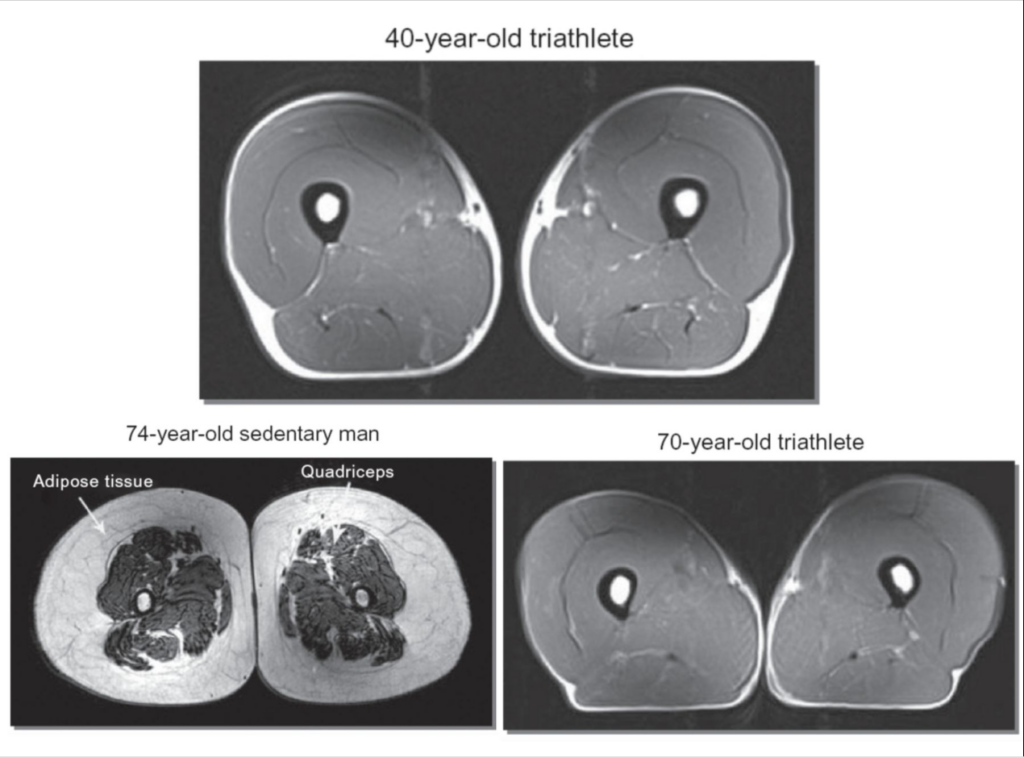In 1513, the Spanish explorer Ponce de León set sail from Puerto Rico with three ships and a crew of experienced sailors to find the Fountain of Youth — a mythical spring with the power to rejuvenate those who drank or bathed in its waters.
Despite his failure to locate the mythical spring (he found Florida instead), Ponce de León’s quest inspired generations of explorers and treasure hunters to continue searching for the Fountain of Youth.
While this enchanted spring may be the stuff of legends, recent scientific breakthroughs have brought us closer than ever to unlocking the secrets of maintaining our strength as we age.
One of the biggest keys lies in understanding and combating a condition called sarcopenia. In this article, we’ll talk about what sarcopenia is, what it happens, and what you can do to fight it.
The Sobering Reality of Sarcopenia

Sarcopenia is defined as the age-related decline in skeletal muscle mass, strength, and function. It may seem like a distant concern for you if you’re in your 40s and 50s. But the truth is that the foundations of sarcopenia begin early.
In our 30s, sarcopenia starts to gradually chip away at our strength and vitality. By taking action in your 30s and 40s, you can significantly reduce the impact of sarcopenia as you age. Preserving your strength and mobility now is crucial if you want to be able to do what you do now later on in life.
According to a study published in the Journal of Cachexia, Sarcopenia, and Muscle, adults between the ages of 40 and 50 can experience an average decline in muscle mass of about 0.5% to 1% per year. This rate of decline accelerates after the age of 50, reaching up to 2% per year. As a result, by the time individuals reach their 70s and beyond, sarcopenia can have a devastating effect on their independence and well-being.
If you’re around my age, you watched your parents go through this.
I saw my dad gradually lose more and more of his physical strength. It wasn’t that big of a deal. Until he ended up in intensive care for a bacterial infection. The doctors cured his infection. But all the time he spent in bed recovering caused his strength and muscle to disappear.
It was the beginning of the end for him after he got back home. He died 5 months later.
The Great News
I know it might be depressing to think about the biological reality of aging. Your hair turns grey (or falls out in my case) and your skin gets weird. But take a look at the photo below for a moment.
It shows the leg muscles of a 40-year-old triathlete, a 74-year-old sedentary man, and a 70-year-old triathlete.
Can you see that the difference in muscle is hardly noticeable between the two triathletes despite the 30-year age difference? So much of what we think of as aging is optional.
With muscle, it’s a “use it or lose” situation.
It’s important to understand that your habits are what causes muscle loss to accelerate. Not your age. So it’s within your power to do something about it.
The Science Behind Sarcopenia
We’re still figuring out all the factors that cause sarcopenia. Although staying physically active is a key component, the reasons go beyond just hitting the gym.
Some of the factors contributing to sarcopenia include:
- Chronic inflammation: Systemic inflammation can cause muscle wasting and impair muscle synthesis.
- Oxidative stress: Accumulation of reactive oxygen species (ROS) can damage muscle cells and impair muscle function
- Mitochondrial dysfunction: Age-related decline in mitochondrial function and biogenesis can affect muscle energy production
- Cellular senescence: Accumulation of senescent cells can impair muscle regeneration and function
- Inactivity: Sedentary lifestyles and reduced physical activity can exacerbate muscle atrophy
- Protein intake: Inadequate dietary protein and essential amino acid intake can lead to decreased muscle synthesis
- Sarcopenic obesity: Increased fat mass can contribute to muscle inflammation and impair muscle function
As you can see, some of the factors are more complex to address. And others, such as how much protein you eat and how active you are, are 100% in your control.
Now that we understand the factors behind sarcopenia, let’s look at the science-based strategies to help combat it.
Actionable Advice to Combat Sarcopenia

1. Embrace Resistance Training
Multiple randomized controlled trials (RCTs) have demonstrated that resistance training is one of the most effective ways to combat sarcopenia. A study published in Medicine & Science in Sports & Exercise found that participants who engaged in progressive resistance training twice a week for 12 weeks experienced significant improvements in muscle strength and function.
Action: Make two workouts a week your minimum. It can be resistance band and bodyweight training at home or hitting a full gym. Just make sure you get two resistance training sessions in every week.
2. Prioritize Protein
A high-quality protein intake is crucial for maintaining muscle mass. RCTs have shown that consuming adequate protein, particularly after resistance training, promotes muscle protein synthesis and helps prevent muscle loss.
Action: Aim for a daily protein intake of 0.8–1 gram per pound of body weight every day. Or shoot for 50 grams of protein every meal.
3. Get Your Daily Dose of Vitamin D
Low levels of vitamin D have been linked to muscle weakness and a higher risk of sarcopenia. A study published in the American Journal of Clinical Nutrition revealed that vitamin D supplementation significantly improved muscle strength and function in older adults.
Action: Aim for a daily intake of 800 to 1000 IU of vitamin D through a combination of sunlight, food, and supplements, if necessary.

4. Don’t Neglect Omega-3 Fatty Acids
Omega-3 fatty acids, found in fatty fish, flaxseed, and walnuts, have been shown to have a positive impact on muscle mass and function. A study in the American Journal of Clinical Nutrition demonstrated that omega-3 supplementation combined with resistance training led to greater improvements in muscle strength and function in older adults compared to resistance training alone.
Action: Aim to consume at least 2 servings of fatty fish every week or 1–2 grams of fish oil daily.
5. Stay Active
Aerobic exercise not only benefits your cardiovascular health but also supports muscle health. RCTs show that engaging in regular aerobic activities, such as brisk walking, cycling, or swimming, can improve muscle strength and function.
Action: Aim for at least 150 minutes of moderate-intensity aerobic exercise every week.
6. Get Enough Sleep
Adequate sleep is crucial for overall health and muscle recovery. Research has shown that poor sleep quality and sleep deprivation can negatively impact muscle mass and function.
Actions: Aim for 7 to 9 hours of quality sleep every night. Also practice good sleep hygiene by establishing a consistent sleep schedule, creating a relaxing bedtime environment, and avoiding stimulants like caffeine and electronics close to bedtime.
7. Supplement With Creatine
Creatine is a natural compound found in small amounts in certain foods and widely used as a sports supplement, has been shown to improve muscle strength and function, particularly when combined with resistance training. A meta-analysis published in the Journal of Aging and Physical Activity found that creatine supplementation led to greater gains in muscle strength in older adults compared to resistance training alone. Consult with a healthcare professional before starting any supplementation, and consider incorporating creatine to enhance your resistance training regimen.
Action: Take 3–5 grams of creatine monohydrate every day.

8. Stay Hydrated
Proper hydration is essential for overall health and has been linked to optimal muscle function. A study in the Journal of Gerontology revealed that dehydration could negatively impact muscle strength and endurance in older adults.
Action: Make it a priority to drink plenty of water throughout the day, aiming for a minimum of eight 8-ounce glasses.
9. Manage Stress
Chronic stress can have detrimental effects on muscle mass and function. Prolonged stress can lead to elevated cortisol levels, which can result in muscle breakdown and hinder muscle growth.
Action: Implement stress-management techniques weekly. such as mindfulness, meditation, yoga, or deep breathing exercises to help keep stress in check and promote overall well-being.
10. Foster Social Connections
Staying socially active and engaged has been linked to better overall health, including the maintenance of muscle mass and function. A study published in Scientific Reports found that older adults with strong social connections had a lower risk of experiencing sarcopenia.
Action: Nurture your relationships with friends and family, participate in community events, or join clubs and organizations to foster connections and support a healthy, active lifestyle.
The Choice is Yours

Picture two different paths laid out before you.
The first leads to a future where you’re hardly able to move, confined to a chair, relying on others for even the simplest tasks.
The second path reveals a vibrant, active life filled with adventure, independence, and the ability to pursue your passions without limitations.
The choice is yours.
By following the strategies we’ve discussed, you have the power to combat sarcopenia and alter the course of your life. Imagine playing with your grandchildren, hiking through breathtaking landscapes, and dancing the night away at a friend’s birthday party, all while defying what most people believe is the inevitable consequence of age.
The quest for eternal youth may be a myth. But the ability to maintain our strength, vitality, and independence as we age is within our control. And with the new breakthroughs in medicine that are coming, staying in the best shape you can is going to be crucial to benefit from these technologies.
It’s time to take action.
The modern Fountain of Youth is no longer a fantasy; it’s a reality that awaits you as you choose the path of health.
Related Episodes:
Ted Tak 148: How to Build Muscle After 50? – Ask Ted
Links Mentioned
Want To Lose Fat, Transform Your Body & Live Your Best Life In 2023?
I’m offering this blueprint that will lead you to a fail-proof long-lasting result with your body, with your health that will help you reach that potential that you have inside and become your own super self.
If you’re interested in working with me, schedule a Breakthrough Call and we will discuss your goals, challenges and see if we are a good fit.
>>Click Here To Schedule A Call With Me Now!









